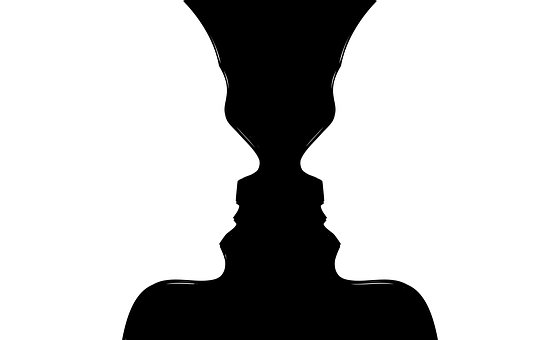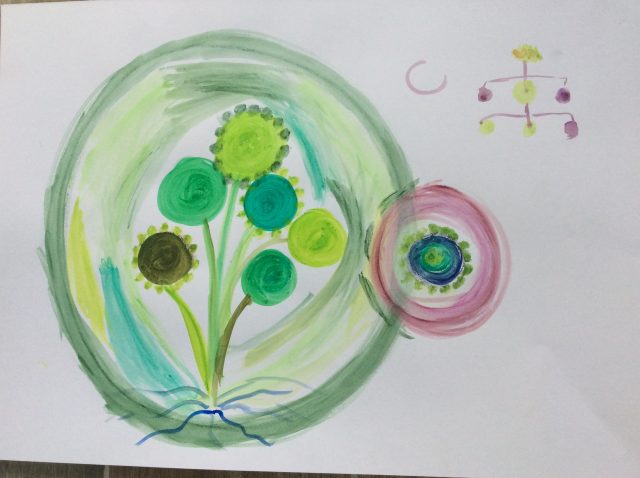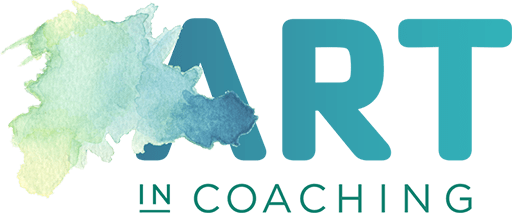‘Our talent for division, for seeing the parts, is of staggering importance – second only to our capacity to transcend it, in order to see the whole.’
Iain McGilChrist, The Master and His Emissary
I believe that one of the most powerful reasons for consciously working with the right hemisphere is its ability to pay attention to the world we inhabit as a whole. Whilst the left hemisphere sees the world in units, the right hemisphere experiences it as a whole, as it really is and in context, both spatially and in the relationships between things. The right hemisphere sees how things are connected and work with other things around them. It has a holistic and Gestalt perception of the world. Because of this, the right hemisphere is also comfortable with complexity and paradox; it can hold whatever it is, as a whole, without the need to analyse it or rationalise it.
Puzzle images
 One way of experiencing some of this are the famous puzzle images, such as the Rubin vase. When looking at this image you may see a vase or you may see two faces, or you may be able to see both at the same time and not be at all concerned about it. If it is the latter, this is the right hemisphere in action, holding the paradox. Usually we will see one or the other to begin with, and have to ‘look’ for the other. At first this can feel a little uncomfortable and then the right hemisphere enables us to say, it’s okay, it’s both!
One way of experiencing some of this are the famous puzzle images, such as the Rubin vase. When looking at this image you may see a vase or you may see two faces, or you may be able to see both at the same time and not be at all concerned about it. If it is the latter, this is the right hemisphere in action, holding the paradox. Usually we will see one or the other to begin with, and have to ‘look’ for the other. At first this can feel a little uncomfortable and then the right hemisphere enables us to say, it’s okay, it’s both!
Complexity and paradox
Our clients can often bring quite complex issues and even paradoxical ones into coaching including emotional and relational complexity, managing conflicting values or the tensions between ‘shoulds’ and ‘oughts’. Enabling clients to work with these complexities is extremely important if they are to make sense of and move through them positively. However, these complexities and paradoxes can be difficult, if not seemingly impossible, to articulate and therefore work with. Clients can be lost for words, explaining that they ‘know’ but can’t describe it, they may be able to tell us what it feels like but can’t analyse it. Perhaps they know what is it isn’t or just have a sense of something. The right hemisphere cannot communicate because it is silent relying on left hemisphere to find the words which it doesn’t have. The left hemisphere may also actively suppress the data because it wants to maintain certainty (See Frame shifts and the right hemisphere). To help our client break through this we need to work with their right hemisphere and encourage their left hemisphere to relinquish control.
Coaching with art
The imaging and creative process within art based coaching is an embodied experience and replicates the right hemisphere’s ability to see things as a whole, in context, with all the complexity and paradox that may be within it. The process enables a client to externalise the complexity of their whole experience into a safe space (the visually created image) and, by so doing, makes it easier for them to reflect and explore the issue with curiosity, taking as long as they need to find their own meaning and understanding within it.
A great example of this was in my first coaching session with Sam which I included in Coaching Beyond Words – Using Art to Deepen and Enrich Our Conversations, 2019 Routledge. The following is an extract from the book (Chapter 4 page 27).

Sam’s image showing the tensions between change, growth and constraint
‘Sam was exploring her role in the professional organisation she had recently joined as a director. Sam had been recruited to bring about change and introduce best practice. Sam’s image captured the situation for herself; not only the organisation, but how she felt, the tensions within the organisation around change and the complexity of the relationships within it. Sam described the green circle with the round flowers within it as representing the organisation and the different ornamentations on the flowers representing different variations within the profession. The blue roots coming from the flowers extending just beyond the green circle symbolised the potential for growth in the organisation. Sam, although from the same profession, has shown herself as a purple circle pushing its way in to the green circle. The additional images relate to the organisation’s structure; the organisational hierarchy representing those from the profession in green and those not, in purple.
Sam describes the image as ‘…a depiction of the tension between growth and constraint, between innovation and reservation, that seemed to be a unifying theme across the issues I had been contemplating earlier, although I hadn’t recognised it as such at that point.’ By externalising the whole issue into one image, giving Sam the space to explore the complexities within it, she was able to understand what was going on for her. It also allowed for some deeper awareness – ‘It was a revelation to me that I still felt an outsider in this job’ – leading to an exploration of difference in later sessions.
Being able to see things as a whole also opens up the possibilities of frame shifts and aha! moments as clients can include diverse and what may seem to be unrelated perceptions into their image, allowing the right hemisphere to explain the connections and relationships between them. This in turn can unlock hidden aspects of themselves and lead to creative and transformational solutions.
References:
McGilChrist, The Master & His Emissary, 2012 Yale (pages 46 to 53)
Sheather, Coaching Beyond Words – Using Art to Deepen and Enrich Our Conversations, 2019 Routledge


One comment on “Working with the whole, as it really is in all its complexity”